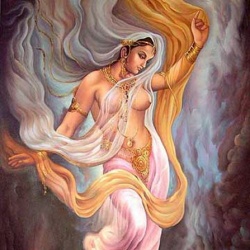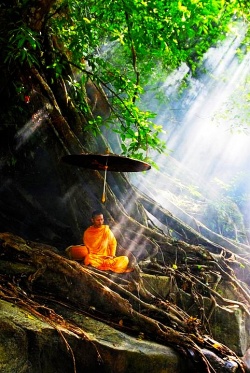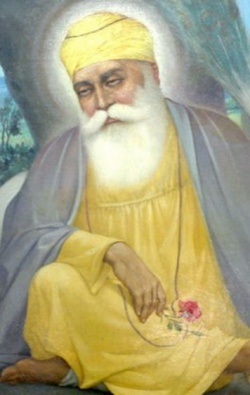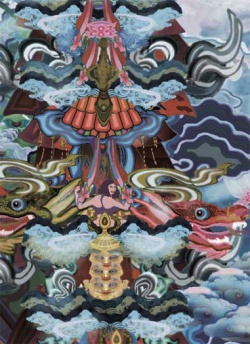The Song of Supplicating Machig Labdrön
by Karma Chagmé
The Song of Supplicating Machig Labdrön by Karma Chagmé (1613-1678), also known under the name Raga Asya, was born in the area of Ngomtö in Salmo Gang in Kham. His father was the great siddha Pema Wangtra and his mother, Chökyong Gyi, was considered a dakinı. His parents named him Wangtra Sung, and when he was five years old he recognized the resting and moving aspects of the mind and realized the generation stage of deity visualization. From the age of six, his father taught him reading, writing, meditation, sadhana practice, and ritual in the Nyingma tradition. When he was ten years old, he received empowerment from the Fifth Situpa, Chökyi Gyaltsen Balsang (1586-1657), after which he stayed in solitary retreats until he was eighteen.
During that time, he presented his realization to the Fourth Trungpa Rinpoché, Kunga Namgya (1555-1628), who bestowed upon him the oral transmission of Avalokitesvara and the pointing out instructions of Mahamudra. When he was eighteen, Karma Chagmé took refuge and upasaka vows from Trungpa Rinpoché, receiving the name Karma Samdrub. Following Trungpa Rinpoché’s command, he entered the monastery of Satam, but the disciplinary monks there kept beating him all the time.
Finally, after nine months, he decided to leave and go to the seat of the Karmapas in Tsurpu. He wrote some insults on the walls of his monastery and escaped. At Tsurpu, he was held up outside the walls of the monastery by Lama Wagen (“Old Fox”) and the disciplinarians beat him up again. Having escaped them one more time, in the surroundings of Tsurpu, he happened upon a monastic barber, who approached him and said that it was not appropriate to behave in such a way and then leave. He continued that this assembly of monks is well-trained and learned and that this lama is Maitreya in person.
Finally, the barber accompanied Karma Chagmé to the assembly hall of Tsurpu, where he turned out to be the Sixth Shamarpa, Chökyi Wangchug. Thus, Karma Chagmé became a disciple of both the Tenth Karmapa, Chöying Dorje, and the Sixth Shamarpa. He studied the classic topics of the sutra tradition (such as Madhyamaka and prajñaparamita), the five treatises of Maitreya, the Hevajra Tantra, and The Profound Inner Reality. During his studies, he entered the White Mañjushrı samadhi of victory in debate, thus becoming renowned as being unassailable when discussing the dharma.
The Sixth Shamarpa ordained him as a novice, giving him the name Karma Loblam.1061 Upon receiving full monastic ordination, his name was changed to Karma Chagmé (“Karma without Attachment”), since the Karmapa declared him to be one of his own physical manifestations, “who has not been attached, will not be attached, and is without attachment.” Karma Chagmé also received instructions on Mahamudra and the Six Dharmas of Naropa from the Karmapa’s secretary, Lodrö Norden,1063 and a number of empowerments and reading transmissions from Lama Wagen.
Once, when he made offerings and prayed in front of the relics of the Sixth Shamarpa, the wisdom of Mahamudra was born in his mind stream. Thereafter, he joined the monastery of Tubden Nyingje Ling of the Surmang tradition and continued his studies. When the Karmapa and the Shamarpa visited this monastery, he received further instructions on Maitreya’s treatises, Jigden Sumgön’s famous Single Intention of the Genuine Dharma, Mahamudra, Cakrasamvara, Vajravarahı, and many other teachings and empowerments for six months. Then, he accompanied the Karmapa on his travels for about one and a half years and became famous throughout Tibet.
In his twentieth year, Karma Chagmé passed a public examination during the great Kagyü prayer festival in front of many thousand monks. Later, upon taking the bodhisattva vows in front of the Jowo statue in Lhasa, while being full of devotion within a state of nonconceptual pure awareness, Karma Chagmé offered one finger of his left hand as a butter lamp. Finally, he traveled to Kham, doing extensive debate rounds on his way at various monastic colleges.
He established a mountain hermitage at Balri Hill in Nedo and stayed there—mostly in strict retreat—until the end of his life. From age thirty-six onward, he practiced the Six Dharmas of Naropa, Mahamudra, and Avalokiteshvara in the form of Jinasagara straight from the heart in a thirteen-year long retreat. During the later part of this retreat, he recognized the “treasure-finder” Mingyur Dorje. After he had finished his seclusion, he bestowed numerous empowerments and transmissions of the terma tradition, such as for the cycle of the Space Dharma to sometimes several thousands of disciples.
Since that time, when the founder of the Béyül lineage of the Nyingma School—Günsang Sherab — received these transmissions directly from Karma Chagmé, they have constituted the essential practices of that lineage. Once, when Karma Chagmé thought that he should go back to Central Tibet to receive more instructions on the tantras, the Sixth Shamarpa appeared in a vision and imparted the heart of the matter to him, prophesying that he would accomplish it if he kept practicing it one-pointedly.
He also had many visions of yidam deities, gained command over all dharma protectors, and showed all the signs and experiences of progressing through the various levels of realization, such as displaying many miraculous powers. Not only did he travel to Sukhavati himself, but also showed his mother, his nephew, and his servant the path to that pure realm. In 1678, after having declared to his disciples that it was time to go to another realm, Karma Chagmé passed away, his mind fusing with the heart of Amitabha.
While his physical remains dissolved into light, rainbows and a rain of flowers appeared spontaneously and many relic pills formed. After his cremation, images of Jinasagara were found to have formed on his bones. In brief, Karma Chagmé spent most of his life as a wandering yogin in different mountain retreats. It is said that he attained the Mahamudra level of “greater one taste”1072 in one lifetime. There were many who realized mind’s basic nature simply through receiving empowerments, instructions, or a few words of advice from him. As the colophon of his song to Machig Labdrön so typically says, he only wrote something down when someone requested a teaching. Then he would hand over the sheets to that person, who usually went away with them. So after his death, nobody had a complete set of his teachings.
It is said that he authored more than fifty-five volumes. Some of his teachings were collected later, but many seem to be lost. The most famous of his works are Chagmé’s Mountain Dharma and The Experiential Instructions of the Noble Great Compassionate One, The Quintessence of Making the Unity of Mahamudra and Dzogchen a Living Experience. Namo Guru Dakiye At a place one cubit above the crown of my head, On a triple-layered seat of lotus, sun, and moon, In a tent of dense clouds of rainbow light,
In truth inseparable from the guru in whom I have confidence, Sits the Mother that gives rise to the four noble ones, Machig Labdrön. Her body is white in color, Her long hair hanging loosely down her back. Her face is peaceful and smiling, her three eyes looking into space. Her body [is clad in] a wide-sleeved robe of white silk, fluttering in the wind. Held together at her waist by a girdle of red and white silk. Her legs are in the vajra position. On a moon at her heart, the letter A is surrounded by her mantra. With her right hand she plays a golden damaru, Which fills a trichiliocosm with its sound.
Thus, from the place Akanistha, the pure realm of the dharmadhatu, Her sons, the assemblies of Buddhas, bodhisattvas, and siddhas, Arrive like small pieces of paper dancing in a breeze, All melting into Machig’s body. With her left hand she plays a bell of white silver, Its ringing sound pervading the ten directions. The assemblies of the ˜›kinıs in the twenty-four places Arrive like a swirling blizzard, All melting into the Mother’s body. “You who embody all refuges, Machig Labdrön, I supplicate you from the depths of the strength of my heart. Grant your blessings that I may get to the very pith Of this body, the precious riches and freedoms difficult to obtain.
It is uncertain when its enemy, the lord of death, comes, So grant your blessings that I may have accomplished a mind without regret. 386 straight from the heart Grant your blessings that I may not feel guilty At the courthouse of him, the king of dharma. No matter in which of the six kinds of birthplaces I may be born, I will suffer, So grant your blessings that the doors to being born there may be barred. Grant your blessings that trust may arise in my mind In the [three] jewels who are definitely refuges without betrayal. Grant your blessings that love and compassion may arise For the six types of beings, my kind parents.
Grant your blessings that I may gain stability In my own mind as actually being the bare dharmakaya. Once the body, speech, and mind of Machig Labdrön and myself, Just like pouring water into water, Have become inseparable and one, May I lead all those who are connected with me to great bliss.” Through the power of this my supplication, The great Mother melts into light, which dissolves into me. My true own mind free from reference points is stripped naked.
Now, look in here, look at your own mind. Looking at mind, it is not seen, there is no entity there. This dharma of emptiness is your own mind. Mind is not nonexistent either, it appears as anything whatsoever. The dharma of vividly aware wisdom is your own mind. If mind is happy, look at the nature of being happy. The dharma of bliss-emptiness is Mahamudra. If mind is luminous, look at the nature of being luminous. The dharma of luminosity-emptiness is Mahamudra. If mind is empty, look at the nature of being empty. The dharma of being nonconceptual is Mahamudra . When looking in here, there is nothing to be seen.
The dharma of ordinary mind is stripped bare. the song of supplicating Machig labdrön When looking out there, everything is like a rainbow. Each form is clearly distinct, but their nature is empty. The dharma of all that can possibly appear is a self-appearing illusion. Whatever thoughts of the five mental poisons may surface, Through looking at their own face, they are at peace in their own place. This is the instruction of the dharma of the five poisons being self-liberated.
Whatever expressions of happiness or agony your mind may display, Through looking at their own face, they are at peace in their own place. This is the dharma of equal taste, Mahamudra . As whichever of all the manifold expressions of fear your mind may appear, Through looking at their own face, they are at peace in their own place. This is the dharma of Cutting Through, Mahamudra.
Whatever expressions of suffering your mind may come up with, Through looking at their own face, they calm down in their own place. This is the genuine dharma of the Pacification of Suffering. The mind free from all existence, nonexistence, permanence, and extinction Is the genuine dharma of Madhyamaka. That there is not a single phenomenon that is not perfect within the mind Is the genuine dharma of the Great Perfection. 388 straight from the heart The minds of the Victors above, your own mind, And the minds of your mothers—the six kinds of beings—are one in nature. To see this is the inseparability of cyclic existence and nirvana. Leave this mind without a point to which you direct it in your meditation. This is naked ordinary mind. Leave the mind without something to look at and a looker. This makes Mahamudra a living experience.
The dharma of untainted view and conduct Is to guard your three vows like your eyeballs. This means to carry along the two rivers of Kadampa and Mahamudra. It is the attainment of stability of your own true mind, Which is given the name “fruition.” This is the fruition of the dharma of the secret mantra’s system. Thus I wrote on the thirteenth day [of this month] by the side of a butter lamp. You who have the persevering strength of heart for accomplishment in one lifetime, You Lady, who hold the lineage of Machig Labdrön, Have commissioned me [to compose this] out of confidence in me. Therefore, make your daily practice with confidence in these words. Raga Asya sent this on a sheet of paper from his camp at the Dharma Mountain in Upper Yöl to the Mountain Cave Lady.
Mangalam, may there be auspiciousness!




